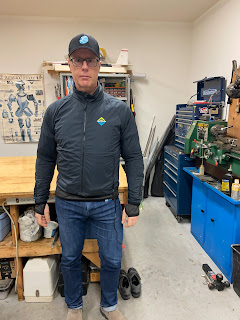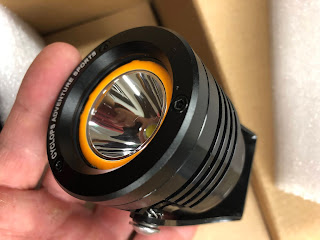 |
| Another type of tail tidy... |
If you've been following up-and-coming UK ADV gear company Adventure Spec, you'll be aware that for the past two years they've been developing an armoured shirt to meets Europe's stringent AA standard for motorcycle protective gear. Last year, Adventure Spec revealed their development program and offered early adopters a chance to get one of the first production items. I immediately plunked down a buck to hold a place in the pre-order line. Today, after a year of development delays and then a website ordering demand that appeared to have set servers on fire, I finally was able to purchase and receive one of only 48 or so "Supershirts" allocated to North American customers. While I haven't had a chance to ride in the shirt yet, here are some initial observations that may help you determine if this is the right gear for you when the Supershirt is officially launched and inventory becomes available later this summer.
For reference, I'm 183 cm tall (6'-1") and 91 kg (200 lbs) of generally athletic build, but carrying a bit more middle than usual. My chest is 107 cm (42") and waist about 88 cm (34"-35") depending on pants and how many tacos I've just eaten. For most riding gear I seem to fit a Large, so that's the size of Supershirt I ordered. It fits perfectly: snug but not uncomfortably tight, with perfect sleeve length to slot my thumbs in the holes and not have wither bunched fabric or numb thumbs.
 |
| Back protector is about 16.5" long. |
 |
| The AlpineStars back protector extends over the lumbar region. |
 |
| The AlpineStars mesh is fragile and the armour isn't removable. |
 |
| The back protectors are almost identical in shape and size. |
The Klim jacket with armour removed weighs 1310g. Adventure Spec offers their "Singletrack" waterproof jacket which weighs 710g. While I agree with Adventure Spec's philosophy of "light is right", the combination of Supershirt and Singletrack jacket weighs 2412g compared to 2010g for the Klim Carlsbad with armour in. Of course, with the Adventure Spec combo you're getting certified Level 2, AA protection (versus Level 1 for the Carlsbad) as well as a chest protector. The additional protection comes with a weight penalty. I think the main advantage of the Supershirt in this case is you don't need the jacket: the shirt alone serves as the outer layer. So really, you're comparing a lighter, breathable (but not waterproof) protective layer with a waterproof (but not breathable) and heavier jacket.
Of course, it's unlikely I'd wear just the heated jacket over top (although that's an interesting idea to test). So here's the whole shebang layered with the Klim on top.
This made me feel more like a sausage and my forearms were noticeably less comfortable. But it does work, and usually when it's cold and wet for me (like 10 hours of rain at 8C) it's because I'm stuck on a long highway run and not trying to navigate technical trails where more mobility is required.
- It's one, breathable layer offering CE AA protection. Wow! I anticipate this transforming how I enjoy my riding, especially in hot weather.
- It's comfortable to wear but tough material. Construction quality is high.
- Armour is well placed and held snugly in position.
- Although the garment has been tested and certified to meet the CE AA rating, I'd like to see the back protector extend to the lumbar region as that can be a high-impact area (as with the tail bone) in trail riding.
- Neck hole could be a wee bit lower in front.
- Armour pockets could use a tweak so fingers don't snag so easily on them.
- Adding a second, lower pocket pouch for the back protector (or a Velcro sizing adjuster in a single, larger pouch) could allow the use of a longer back pad for lumbar protection if desired.
- Adding a couple of Velcro strips on the back would make it easy to attach an optional kidney belt (a.k.a. belly modifier...ahem).
- Cost. I received a "VIP" discount as a result of being an early-adopter a year ago and feel the price even at full retail is fair considering the quality of the garment. However, as a Canadian, the combination of USD to CAD exchange rate coupled with an exorbitant shipping/brokerage fee from UPS ($160!), taxes, and duty brought my final price to CAD$568.81--almost double the cost of the shirt. The regular retail cost to Canadians will be significantly more than that (no VIP discount). In my experience with ordering international goods shipped to Canada, it's often been much cheaper (and faster) to order direct from the EU, Japan, or Australia than from the US. I would like to see more vendors offer Canadians more fulfillment options. I raised these points with Adventure Spec and they recognize the issue and are considering options.
















































